-
Car Reviews
- All reviews
- Midsize SUVs
- Small cars
- Utes
- Small SUVs
- Large SUVs
- Large cars
- Sports SUVs
- Sports cars
- Vans
Latest reviews
- Car News
-
Car Comparisons
Latest comparisons
- Chasing Deals
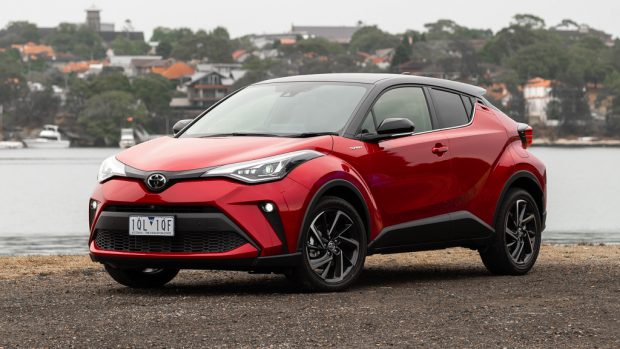
Originally developed for the European market, Toyota Australia fought hard to secure the quirky C-HR crossover for our market. When it first launched in 2017, the C-HR surprised us in several ways: this wasn’t just another amorphous blob of a compact crossover, but a design that stood out – and it even drove well! The C-HR’s reasonable sales tally since then is no surprise, with buyers ignoring the limited rear seat space in favour of an SUV with verve and athleticism. Now, the C-HR has pulled in for its first facelift – so, how’s it ageing?
The 2020 update to the C-HR is a relatively subtle one, with three key changes. The first is a minor design update to the front and rear styling, while new wheels have also been added. Inside, there’s a larger head unit with Apple CarPlay and Android Auto, which were missing in the original iteration. Thirdly, Toyota have snuck an extra drivetrain into the line-up – a 1.8-litre hybrid unit available only on the top-shelf Koba.
Tom reviewed the hybrid here – this time, we’re testing the conventional 2020 C-HR Koba turbo petrol: a 1.2-litre unit with outputs of 85kW/185Nm. Our test car, which was fitted with optional Feverish Red metallic paint ($500) with a contrasting black roof ($450) saw the on-road price hit $38,827 driveaway.
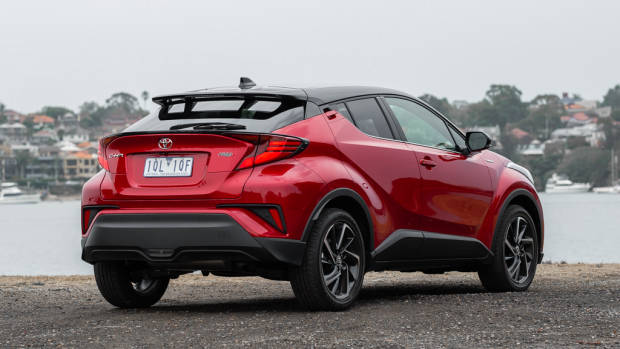
The exterior of the C-HR remains this car’s strongest drawcard, though it isn’t to all tastes – I will admit that there is some fussy surfacing, though the Toyota certainly sets itself apart from the ubiquity of the small SUV crowd. With the 2020 update comes a slightly restyled front bar with the cross-member now in black plastic instead of body colour and a new set of 18-inch alloy wheels for the Koba that look somewhat aerodynamic.
<h3?Driving the C-HR Koba
The best seat in the C-HR is absolutely the driver’s seat. Toyota’s TNGA architecture is largely to thank for this: the C-HR is endowed with prodigious chassis stiffness which permeates through the driving experience. Cruising around Sydney’s pot-holed roads the C-HR remains entirely unflustered. The ride is on the firm side, but even with big 18-inch rubber and stiff-sidewall Bridgestone Potenzas there is never any crashing transmitted into the cabin.
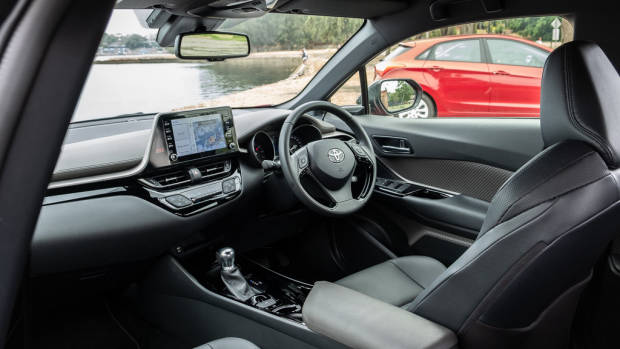
The firm ride really comes into its own outside the C-HR’s suburban comfort zone, where this SUV exhibits exemplary body control and a balanced chassis. An upside of the C-HR’s good neutral balance is that when driven with more enthusiasm the little crossover provides entertainment for keen drivers, with ESP calibrated to allow a little play before reigning in the fun. Throwing it through some tight turns on bitumen and dirt reveals a chassis with keen turn-in and natural throttle adjustability that makes the C-HR feel more like a warm hatch than a soft roader. Bring on a hotter Gazoo Racing version!
Another highlight is the C-HR’s steering. The ratio feels natural and adequately communicative at speed while shifting to very light and easy to twirl at city speeds. As its exterior styling suggests, visibility can be a problem with the C-HR. The innovative design means rear three-quarter vision is often obscured and you have to rely on the Koba’s new, but grainy, 360-degree camera to park accurately.
Similarities to a hot hatch stop at the engine. Initially developed for the European market, the 1.2-litre petrol engine is zingy and willing, with good response and acceleration up to 80km/h – but at highway speeds, progress is merely acceptable.
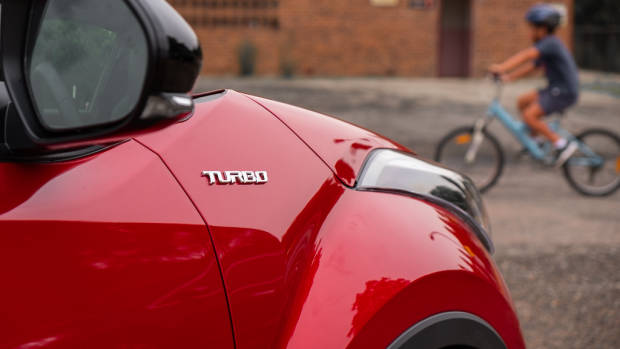
A CVT automatic transmission is the sole gearbox; it does the job, but becomes buzzy under hard acceleration. It’s something of a shame that the slow-selling six-speed manual that was available on last year’s base model has now been dropped from the range, as it paired better with the 1.2-litre turbo than the CVT.
On our diverse test route the fuel consumption missed the claimed figure of 6.2l/100km, returning a disappointing 9.2l/100km despite the highway biased test. The 50-litre fuel tank is on the small side for Australian use, too.
The C-HR’s European target market dictated a higher-quality selection of materials than in many other Toyotas. The driver’s seat might be the place to be, but up front, both passengers benefit from a plethora of soft-touch materials on the dash and doors, giving a premium air to the cabin.
Generally, the front seats are very comfortable, save for the lack of under-thigh support for taller drivers. The driving position is well judged, high enough to see out well, but the high beltline means you feel cocooned.
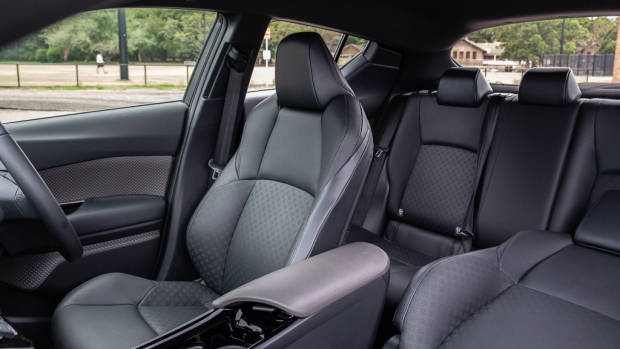
The 2020 C-HR benefits from an updated touchscreen head unit that grows in size and now supports modern smartphone mirroring software. Toyota’s own software feels quite dated, but we think most drivers will plug their phone in and skip the Toyota skinning altogether.
Scratchy plastics do rear their head around the centre console, just where my knee touches, and it’s a shame that the doors are almost entirely hard in the second row. Speaking of the back, our complaints from the car’s initial release continue. The rising window line substantially constrains the view out for rear-seat passengers – especially kids. The lack of air vents (or USB charge points) is also very unusual at this price point.
The C-HR’s boot sits behind a heavy door that would benefit from electric operation, which is missing. Space in the cargo area is among the smallest in the class at 377 litres, but that doesn’t tell the whole story: we found it to have quite a practical storage area that is square and easy to load, given the lack of a load lip. There are shopping bag hooks, though they’re flimsier than in rivals. The load-space is completely flat when the rear seats are folded, and a road bike will fit inside easily, with both wheels on. A space-saver spare lies under the floor, though there are no secret cubbies to be found.
Toyota is a name associated with reliability – most of their cars are built to handle an absolute flogging. On the warranty side, the five year warranty with unlimited kilometres (for private buyers) meets expectations for this class.
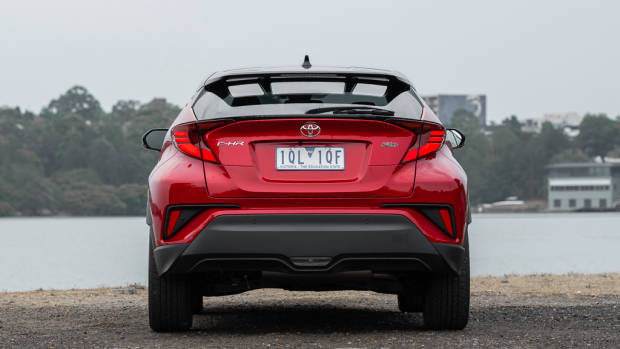
Servicing the C-HR needs to be done annually or every 15,000 kilometres, which is also normal for the class. The first four services are priced at $200 each, which is very much on the inexpensive side for this cohort.
There is an absolute minefield of competitors in the small SUV segment that the C-HR competes in. Fleet sales have driven the Mitsubishi ASX to the top spot but private buyers tend to prefer the Mazda CX-3 and Honda HR-V – though we’d also recommend checking out the Skoda Karoq, or waiting for the forthcoming Volkswagen T-Cross and T-Roc siblings.
The 2020 Toyota C-HR continues to fly high dynamically, and is easily one of the most pleasant vehicles in the segment to drive. With Apple CarPlay and Android Auto now standard, it’s hard to mark it down at all – save for the tight rear seat, and the fact that at over $38,000 driveaway, the Koba model is now quite expensive for a vehicle with such a small engine.
If you rarely travel with more than two passengers and are looking for a funky, fun compatriot that stands up well to everything from urban assault to country roads, we recommend the C-HR – though we’d look particularly closely at the new hybrid model that will save considerable amounts on your fuel bills.
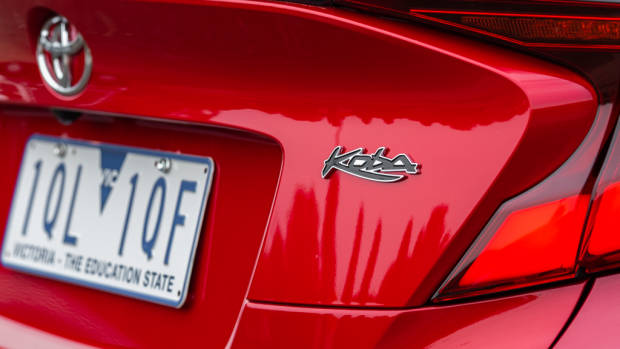
Key specs (as tested)
About Chasing cars
Chasing Cars reviews are 100% independent.
Because we are powered by Budget Direct Insurance, we don’t receive advertising or sales revenue from car manufacturers.
We’re truly independent – giving you Australia’s best car reviews.
The estimate provided does not take into account your personal circumstances but is intended to give a general indication of the cost of insurance, in order to obtain a complete quote, please visit www.budgetdirect.com.au. Estimate includes 15%^ online discount.
^Conditions Apply
Budget Direct Insurance arranged by Auto & General Services Pty Ltd ACN 003 617 909(AGS) AFSL 241 411, for and on behalf of the insurer, Auto & General Insurance Company Limited(ABN 42 111 586 353, AFSL 285 571).Because we don’t know your financial needs, we can’t advise you if this insurance will suit you. You should consider your needs and the Product Disclosure Statement before making a decision to buy insurance. Terms and conditions apply.
Indicative quote based on assumptions including postcode , 40 year old male with no offences, licence suspensions or claims in the last 5 years, a NCD Rating 1 and no younger drivers listed. White car, driven up to 10,000kms a year, unfinanced, with no modifications, factory options and/or non-standard accessories, private use only and garaged at night.
^Online Discounts Terms & Conditions
1. Discounts apply to the premium paid for a new Budget Direct Gold Comprehensive Car Insurance, Third Party Property Only or Third Party Property, Fire & Theft Insurance policy initiated online on or after 29 March 2017. Discounts do not apply to optional Roadside Assistance.
2. Discounts do not apply to any renewal offer of insurance.
3. Discounts only apply to the insurance portion of the premium. Discounts are applied before government charges, taxes, levies and fees, including instalment processing fees (as applicable). The full extent of discounts may therefore be impacted.
4. We reserve the right to change the offer without notice.